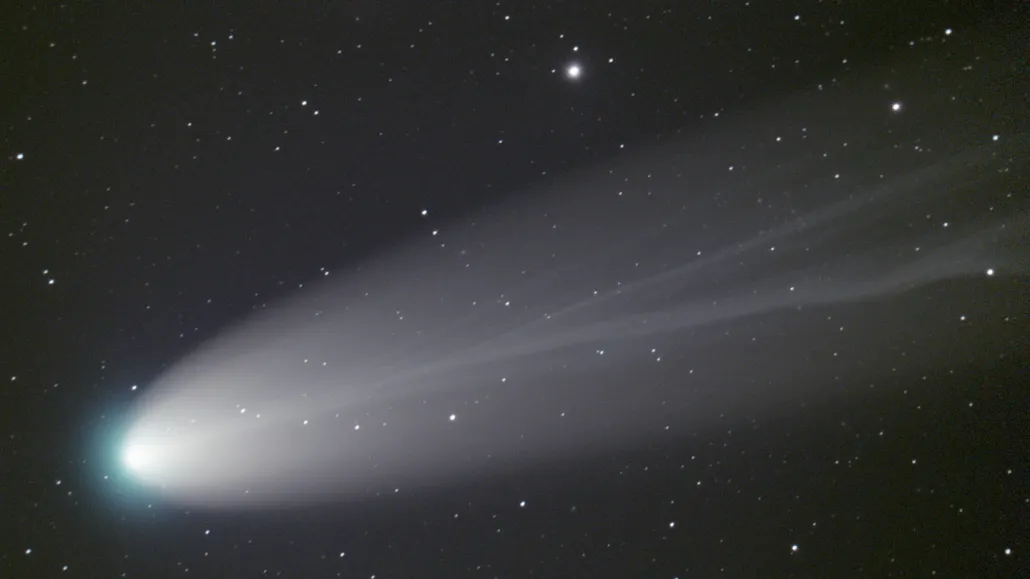Oort cloud comets may spin themselves to death
How icy objects from the solar system’s fringe disintegrate is a long-standing mystery

Comet Leonard dazzled last winter before disintegrating as it approached the sun. One astronomer has now proposed an explanation for how comets like this one break apart.
cafuego/Flickr (CC BY-SA 2.0)
- More than 2 years ago
Comets from the solar system’s deep freezer often don’t survive their first encounter with the sun. Now one scientist thinks he knows why: Solar warmth makes some of the cosmic snowballs spin so fast, they fall apart.
This suggestion could help solve a decades-old mystery about what destroys many “long-period” comets, astronomer David Jewitt reports in a study submitted August 8 to arXiv.org. Long-period comets originate in the Oort cloud, a sphere of icy objects at the solar system’s fringe (SN: 8/18/08). Those that survive their first trip around the sun tend to swing by our star only once every 200 years.
“These things are stable out there in the Oort cloud where nothing ever happens. When they come toward the sun, they heat up, all hell breaks loose, and they fall apart,” Jewitt says.
The Dutch astronomer Jan Oort first proposed the Oort cloud as a cometary reservoir in 1950. He realized that many of its comets that came near Earth were first-time visitors, not return travelers. Something was taking the comets out, but no one knew what.
One possibility was that the comets die by sublimating all of their water away as they near the heat of the sun until there’s nothing left. But that didn’t fit with observations of comets that seemed to physically break up into smaller pieces. The trouble was, those breakups are hard to watch in real time.
“The disintegrations are really hard to observe because they’re unpredictable, and they happen quickly,” Jewitt says.
He ran into that difficulty when he tried to observe Comet Leonard, a bright comet that put on a spectacular show in winter 2021–2022. Jewitt had applied for time to observe the comet with the Hubble Space Telescope in April and June 2022. But by February, the comet had already disintegrated. “That was a wake-up call,” Jewitt says.
So Jewitt turned to historical observations of long-period comets that came close to the sun since the year 2000. He selected those whose water vapor production had been indirectly measured via an instrument called SWAN on NASA’s SOHO spacecraft, to see how quickly the comets were losing mass. He also picked out comets whose movements deviating from their orbits around the sun had been measured. Those motions are a result of water vapor jets pushing the comet around, like a spraying hose flopping around a garden.
That left him with 27 comets, seven of which did not survive their closest approach to the sun.
Jewitt expected that the most active comets would disintegrate the fastest, by puffing away all their water. But he found the opposite: It turns out that the least active comets with the smallest dirty snowball cores were the most at risk of falling apart.
“Basically, being a small nucleus near the sun causes you to die,” Jewitt says. “The question is, why?”
It wasn’t that the comets were torn apart by the sun’s gravity — they didn’t get close enough for that. And simply sublimating until they went poof would have been too slow a death to match the observations. The comets are also unlikely to collide with anything else in the vastness of space and break apart that way. And a previous suggestion that pressure builds up inside the comets until they explode like a hand grenade doesn’t make sense to Jewitt. Comets’ upper few centimeters of material would absorb most of the sun’s heat, he says, so it would be difficult to heat the center of the comet enough for that to work.
The best remaining explanation, Jewitt says, is rotational breakup. As the comet nears the sun and its water heats up enough to sublimate, jets of water vapor form and make the core start to spin like a catherine wheel firework. Smaller cores are easier to push around than a larger one, so they spin more easily.
“It just spins faster and faster, until it doesn’t have enough tensile strength to hold together,” Jewitt says. “I’m pretty sure that’s what’s happening.”
That deadly spin speed is actually quite slow. Spinning at about half a meter per second could spell curtains for a kilometer-sized comet, he calculates. “You can walk faster.”
But comets are fragile. If you held a fist-sized comet in front of your face, a sneeze would destroy it, says planetary astronomer Nalin Samarasinha of the Planetary Science Institute in Tucson, who was not involved in the study.
Samarasinha thinks Jewitt’s proposal is convincing. “Even though the sample size is small, I think it is something really happening.” But other things might be destroying these comets too, he says, and Jewitt agrees.
Samarasinha is holding out for more comet observations, which could come when the Vera Rubin Observatory begins surveying the sky in 2023. Jewitt’s idea “is something which can be observationally tested in a decade or two.”







